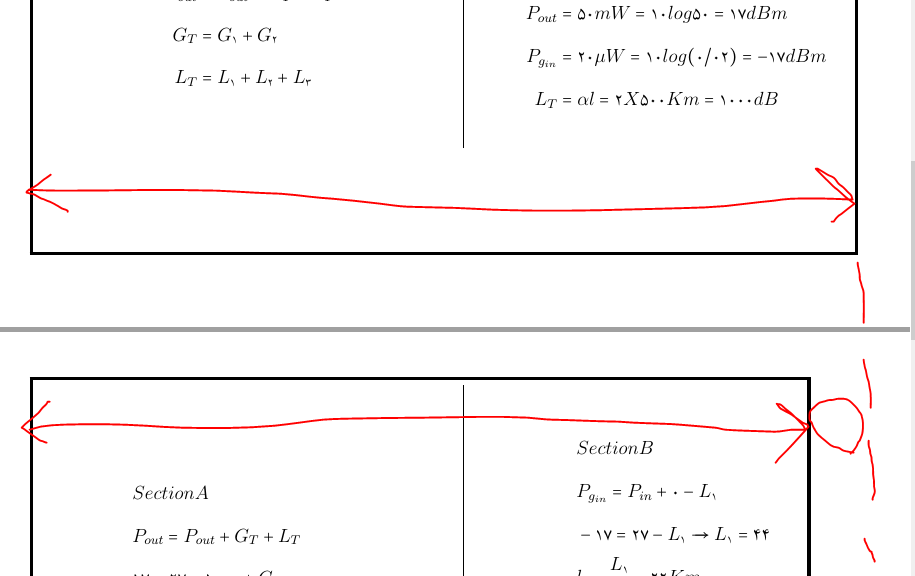با سلام
سوال من در مورد کادر مشکی رنگی هست که در کد زیر ایجاد می شه که به دلیل نامعلومی کادر در صفحات زوج کوچکتر از حالت استاندارد هست و باعث میشه نوشته ها از کادر بیرون بزنن. ممنونم می شم شخصی راهنمایی کنه.

\documentclass[12pt,a4paper]{article}
\usepackage{graphicx}
\usepackage{comment}
\usepackage{setspace}
\doublespacing
%\usepackage{amsthm,amssymb,amsmath}
\usepackage{marvosym}
\usepackage{MnSymbol,wasysym,boldline}
\usepackage{roundbox,graphicx,framed}
\usepackage{fontspec}
\usepackage{fancybox}
\usepackage[top=10mm, bottom=30mm, left=15mm, right=15mm,nohead]{geometry}
\usepackage{array}
\usepackage[font=footnotesize, labelfont=bf]{caption}
\usepackage{pgfplots}
\usepackage{lipsum}
\usepackage{xifthen}
\usepackage{tikz}
\usetikzlibrary{arrows,shapes.gates.logic.US,shapes.gates.logic.IEC,calc,shapes,snakes,automata,shapes.geometric}
\usepackage{xepersian}
\DeclareMathSizes{14}{10}{9}{7}
\settextfont[Scale=1]{XB Niloofar.ttf}
%\settextfont[Scale=1.1]{B_Nazanin.TTF}
\setdigitfont[Scale=1]{Yas.TTF}
\defpersianfont\titr[Scale=1]{XB Titre.ttf}
\begin{document}
\fancypage{}{%
\setlength{\fboxrule}{2pt}%
\fbox}
\vspace{0.3cm}
%\vspace{0.2cm}
\begin{enumerate}
\item
\begin{align*}
y(t)&=2(A cos\omega_ot-3(Acos\omega_ot)^3= 2Acos \omega_ot-3A^3cos^3\omega_ot\\
&=2Acos \omega_ot-3A^3(\frac{3}{4}cos \omega_ot+\frac{1}{4}cos3\omega_ot)\\
&=2Acos\omega_ot-\frac{9}{4}A^3cos\omega_ot-\frac{3}{4}A^3cos3\omega_ot\\
&= \left(2A-\frac{9}{4}A^3\right)cos\omega_ot-\frac{3}{4}A^3cos3\omega_ot\\
Second-Harmonic &Distortion= 0\%\\
Third-Harmonic &Distortion=\left|\frac{2A-\dfrac{9A^3}{4}}{\dfrac{3A^3}{4}}\right|=
\begin{cases}
300\%, & \text{if}\ A=1 \\
42\%, & \text{if}\ A=2
\end{cases}
\end{align*}
\item
\begin{tabular}{ c | c}
\parbox{0.5\textwidth}{
\begin{align*}
P_{in}&=500 mW=10 log 500=27 dBm\\
P_{out}&=50 mW=10 log 50= 17 dBm\\
P_{g_{in}}&=20 \mu W=10 log (0/02)= -17 dBm\\
L_T&= \alpha l= 2X500 Km= 1000 dB
\end{align*}
}
&
\parbox{0.5\textwidth}{
\begin{align*}
P_{out}&=P_{out}+G_{T}+L_{T}\\
G_{T}&=G_1+G_2\\
L_T&=L_1+L_2+L_3
\end{align*}
}
\end{tabular}
\begin{tabular}{ c | c}
\parbox{0.5\textwidth}{
\begin{align*}
&Section B\\
&P_{g_{in}}=P_{in}+0-L_1\\
&-17=27-L_1 \xrightarrow{~} L_1=44\\
&l_1=\frac{L_1}{\alpha}=22 Km\\
&Section D\\
&l_3=500-(l_1+l_2)=230/5\\
Or\\
&P_{out}=P_{g_{2out}}+0-L_3\\
&P_{g_{2out}}=P_{g_{2in}}+G_1=478 dBm\\
&17=478-L_3 \xrightarrow{~} L_1=461 dB\\
&l_3=\frac{L_3}{\alpha}=230/5 Km
\end{align*}
}
&
\parbox{0.5\textwidth}{
\begin{align*}
&Section A\\
&P_{out}=P_{out}+G_{T}+L_{T}\\
&17=27-1000+G_T\\
&G_T=990 \xrightarrow{so} G_1=G_2=495\\
&Section C\\
&P_{g_{2in}}=P_{g_{1out}}+0-L_2\\
&P_{g_{1out}}=P_{g_{2in}}+G_1=478 dBm\\
&-17=478-L_2 \xrightarrow{~} L_1=495 dB\\
&l_2=\frac{L_2}{\alpha}=247 Km
\end{align*}
}
\end{tabular}
\item
\begin{tikzpicture}
\draw[step=0.5, gray, very thin](-8.99,-5.99) grid (8.99,-1.03);
\draw[thick,->] (-8.5,-3.5) -- (-3,-3.5) node[anchor=south west] {t};
\draw[thick,->] (-8.5,-6) -- (-8.5,-1) node[anchor=south west] {$x_c(t)_{DSB}$};
\draw[thick,->] (-2.5,-3.5) -- (3,-3.5) node[anchor=south west] {t};
\draw[thick,->] (-2.5,-6) -- (-2.5,-1) node[anchor=south west] {$x_c(t)_{AM_{\mu=0/5}}$};
\draw[thick,->] (3.5,-3.5) -- (8.5,-3.5) node[anchor=south west] {t};
\draw[thick,->] (3.5,-6) -- (3.5,-1) node[anchor=south west] {$x_c(t)_{AM_{\mu=1}}$};
\end{tikzpicture}
\item
\begin{tikzpicture}
\draw[dotted] (0,0) node[anchor=south west]{DSB} -- (0,5) ;
\path (-8,0) node[anchor=south east]{AM} -- (-8,5) ;
\end{tikzpicture}
\item
سیگنال $x(t)$ در شکل زیر نشان داده شده است. از این سیگنال یکبار برای مدولاسیون فرکانس حامل و بار دیگر برای مدولاسیون فاز همان حامل استفاده شده است.
\begin{figure}[h]
\begin{tabular}{*{2}{>{\centering\arraybackslash}b{\dimexpr0.5\linewidth-2\tabcolsep\relax}}}
\captionof*{×}{}
الف) رابطه بین $f_\Delta$ و $ \phi_\Delta $ را طوری تعیین کنید که حداکثر فاز سیگنال مدوله شده در هر دو حالت برابر باشد. \\
\\
\\
ب) اگر $f_\Delta=\phi_\Delta=1 $ باشد، حداکثر فرکانس لحظه ایی در هر حالت چقدر است ؟
&
\begin{tikzpicture}
\draw[thick,->] (0,0) -- (4.5,0) node[anchor=north west] {$t$};
\draw[thick,->] (0,-2) -- (0,2) node[anchor=south east] {$x(t)$};
\coordinate (a) at (1,1);
\coordinate (b) at (2,1);
\coordinate (c) at (2, -1);
\coordinate (d) at (3, -1);
\coordinate (e) at (3,0);
\draw[thick] (0,0) -- (a);
\draw[thick] (a) -- (b);
\draw[thick] (b)-- (c);
\draw[thick] (c) --(d);
\draw[thick] (d) -- (e);
\draw[dotted] (a) -- (1,0);
\draw[dotted] (0,-1)--(2,-1);
\draw[dotted] (0, 1) -- (1,1);
\foreach \x in {0,1,2,3,4}
\draw (\x cm,1pt) -- (\x cm,-1pt) node[anchor=north] {$\x$};
\foreach \y in {-1,0,1}
\draw (1pt,\y cm) -- (-1pt,\y cm) node[anchor=east] {$\y$};
\end{tikzpicture}
%\caption*{Weighted, complete graph $K_H$}
\end{tabular}
\end{figure}
\end{enumerate}
\begin{center}
\titr
\end{center}
\end{document}